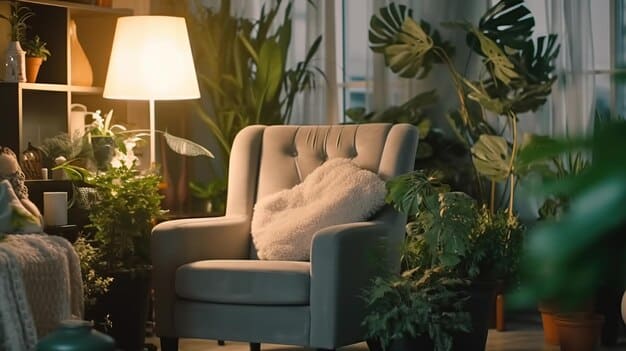Maximise Your Downtime: 4 Relaxation Hacks for Stress Relief

Anúncios
Maximise Your Downtime by incorporating relaxation hacks such as mindfulness, creating a calming environment, engaging in light exercises, and disconnecting from technology to effectively de-stress and rejuvenate after a long day.
After a long, demanding day, finding effective ways to unwind and de-stress is crucial for your overall well-being. It’s about reclaiming those precious moments and making them work for you. Let’s explore how to maximise your downtime: 4 relaxation hacks to de-stress after a long day, helping you recharge and prepare for what’s next.
Anúncios
Embrace Mindfulness for Instant Relaxation
Mindfulness is a powerful tool that can help you centre yourself and find peace amidst the chaos of daily life. By focusing on the present moment, you can reduce stress and enhance your overall sense of well-being. It’s about being deliberate in your awareness and letting go of worries about the future or regrets about the past.
Understanding Mindfulness
Mindfulness involves paying attention to your thoughts, feelings, and sensations without judgment. It’s about observing your experiences as they unfold, acknowledging them, and then letting them go, allowing a sense of calm to settle over you.
Anúncios
How to Practice Mindfulness
There are many ways to incorporate mindfulness into your downtime, such as meditation, deep breathing exercises, and mindful walking. Even simply taking a few minutes to focus on your breath can make a significant difference.
- Find a quiet space where you won’t be disturbed.
- Sit comfortably and close your eyes.
- Focus on your breath, noticing the sensation of each inhale and exhale.
- When your mind wanders, gently redirect your attention back to your breath.
Practising mindfulness regularly can significantly reduce stress and improve your overall mental health. By carving out even a few minutes each day, you can create a habit of calm that carries over into every aspect of your life. It’s a gift you give yourself, a moment of peace in a busy world.
Create a Calming Environment at Home
Your home should be a sanctuary, a place where you can truly relax and unwind. Creating a calming environment can help you de-stress and recharge after a long day. It’s about designing a space that promotes peace and tranquillity. What matters most is fostering an atmosphere that resonates with your personal sense of calm.

Declutter and Organise
A cluttered space can lead to a cluttered mind. Taking the time to declutter and organise your home can create a sense of order and calm. Start with one small area, such as your desk or bedside table, and gradually work your way through the rest of your space.
Incorporate Soothing Elements
- Use soft lighting to create a warm and inviting atmosphere.
- Add indoor plants to bring nature indoors and purify the air.
- Choose calming colours for your walls and décor, such as blues, greens, and neutrals.
Turn your bathroom into a spa-like retreat with aromatherapy oils and soft towels. Scented candles, essential oil diffusers, and a curated playlist of soothing music can all contribute to a more relaxed and harmonious home environment. Make sure your bedroom is optimized for rest with blackout curtains, comfortable bedding, and a cool temperature. It’s these thoughtful touches that transform a house into a haven.
Engage in Light Exercises to Release Tension
Physical activity isn’t just about staying in shape; it’s also a fantastic way to release tension and improve your mood. Gentle exercises can help you unwind without overexerting yourself, leaving you feeling refreshed and rejuvenated.
The Benefits of Light Exercise
Light exercises like yoga, stretching, and walking can help to release muscle tension, improve circulation, and boost endorphins. These natural mood boosters can alleviate stress and promote relaxation.
Easy Exercises for Relaxation
Finding the right exercises that fit into your routine is crucial. Whether it is a short walk in the park or a quick yoga session at home, the goal is to incorporate activity that doesn’t feel like a chore.
- Yoga: Gentle poses to stretch and relax muscles.
- Walking: A leisurely stroll in nature to clear your head.
- Stretching: Simple stretches to release tension in your neck, shoulders, and back.
Regular physical activity not only helps you de-stress but also improves your overall health and well-being. It’s about finding what works for you and making it a consistent part of your routine. Even a short burst of activity can make a big difference, bringing both physical and mental relief.
Disconnect From Technology to Recharge
In today’s digital age, it’s easy to feel constantly connected and overwhelmed. Disconnecting from technology, even for a short period, can provide a much-needed opportunity to recharge and reconnect with yourself. Finding that balance is paramount.
The Impact of Technology on Stress Levels
Constant exposure to screens and notifications can overstimulate your brain and increase stress levels. Taking regular breaks from technology can help to reduce this stimulation and promote relaxation. It also sets the stage to focus on activities and routines that lower stress.
Simple Ways to Disconnect
From establishing tech-free zones to setting specific times when you won’t use gadgets. Every small effort counts towards reducing digital fatigue.
- Establish tech-free zones in your home, such as your bedroom or dining room.
- Set specific times each day when you disconnect from all devices.
- Engage in activities that don’t involve screens, such as reading, gardening, or spending time with loved ones.
Disconnecting from technology allows you to fully engage with the present moment and enjoy the simple pleasures of life. It’s about creating space for relaxation, reflection, and connection with yourself and others. Reconnecting with real-life experiences can prove surprisingly soothing and fulfilling, providing a profound sense of calm and contentment.

Practice Deep Breathing Exercises
Deep breathing exercises are a simple yet effective way to calm your mind and reduce stress. By consciously controlling your breath, you can activate your body’s relaxation response and lower your heart rate and blood pressure.
The Science Behind Deep Breathing
Deep breathing stimulates the parasympathetic nervous system, which is responsible for the “rest and digest” response. This counteracts the effects of the sympathetic nervous system, which is activated during times of stress.
Techniques for Deep Breathing
There are several deep breathing techniques you can try, such as diaphragmatic breathing, box breathing, and alternate nostril breathing. Experiment with different methods to find what works best for you.
Practising deep breathing regularly can help you manage stress and improve your overall well-being. It’s a skill that you can use anytime, anywhere, to bring yourself back to a state of calm and focus. It helps to restore balance in your mind and body, contributing to a sense of peace and tranquillity.
Cultivate a Soothing Bedtime Routine
Your bedtime routine sets the stage for a restful night’s sleep. Creating a consistent and calming routine can help you unwind and prepare your mind and body for sleep. It’s about signalling to your body that it’s time to wind down and rest.
Elements of a Soothing Bedtime Routine
A good bedtime routine might include activities such as taking a warm bath, reading a book, listening to calming music, or meditating. The key is to find activities that help you relax and reduce stress.
Tips for a Better Bedtime Routine
Consistency is key when it comes to establishing a bedtime routine. Try to go to bed and wake up at the same time each day, even on weekends. It involves more than shutting off your devices and climbing into bed. Consider what activities genuinely soothe you. By understanding and implementing what best relaxes you, you can optimize your sleep schedule.
- Set a consistent bedtime and wake-up time.
- Create a relaxing environment in your bedroom.
- Avoid screen time before bed.
A soothing bedtime routine can improve your sleep quality and help you wake up feeling refreshed and energised. It’s an investment in your overall health and well-being. A carefully curated bedtime routine sets the stage for better sleep, which has ripple effects on your mood, energy levels, and overall quality of life.
| Key Point | Brief Description |
|---|---|
| 🧘 Mindfulness | Practice present moment awareness. |
| 🏡 Calming Environment | Create a peaceful home space. |
| 🚶 Light Exercises | Engage in gentle physical activity. |
| 📱 Disconnect | Take breaks from technology. |
Frequently Asked Questions
▼
Mindfulness meditation involves focusing on the present moment without judgment. It can help reduce stress and improve overall well-being through awareness of thoughts and sensations.
▼
To create a calming environment, declutter your space, use soft lighting, incorporate plants, and choose soothing colors. These elements contribute to a relaxed atmosphere.
▼
Good light exercises for relaxation include yoga, stretching, and walking. These activities release muscle tension and boost endorphins, promoting a sense of calm.
▼
Disconnecting from technology reduces overstimulation and stress. It allows you to recharge, reconnect with yourself, and fully engage in real-life experiences.
▼
Deep breathing activates the parasympathetic nervous system, which promotes relaxation. It lowers heart rate and blood pressure, helping you manage stress more effectively.
Conclusion
Maximising your downtime is essential for your well-being. By incorporating mindfulness, creating a calming environment, engaging in light exercises, disconnecting from technology, practising deep breathing, and setting up a soothing bedtime routine, you can efficiently de-stress and improve your quality of life.





